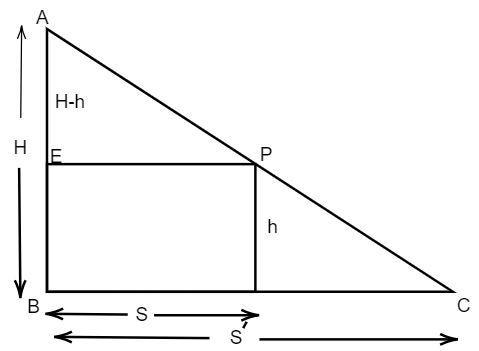
A man walking with a speed $V$ (constant in magnitude and direction) passes under a lantern hanging at a height $H$ above the ground (consider lantern as a point source). Find the velocity with which the edge of the shadow of the man’s head moves over the ground, if his height is $h$ .
(A) $\dfrac{{Vh}}{{H - h}}$
(B) $\dfrac{{Vh}}{{H + h}}$
(C) $\dfrac{{VH}}{{H - h}}$
(D) $\dfrac{{VH}}{{H + h}}$
Answer
216.3k+ views
Hint: For the given condition, construct the diagram. From that identify the similar triangles and construct the relation. Substitute the known parameters and the distance formula in it. Simplifying the obtained relation provides the value of the velocity.
Useful formula:
The formula of the distance is given by
$d = vt$
Where $d$ is the distance, $v$ is the velocity and $t$ is the time taken.
Complete step by step solution:
It is given that the speed of walking by the man is $V$ , height of the lantern is $H$ and height of the man is $h$ .
Let us consider that the shadow of the man moves with the velocity $V'$ .
Let us construct the diagram for the given conditions.

From the above diagram, it is clear that the $\Delta ACB$ is similar to $\Delta ADE$ , so
$\dfrac{{ED}}{{AE}} = \dfrac{{BC}}{{AB}}$
Substituting the known parameters in the above step, we get
$\dfrac{S}{{H - h}} = \dfrac{{S'}}{H}$
Substituting the formula of the distance in the above step, we get
$\dfrac{{Vt}}{{H - h}} = \dfrac{{V't}}{H}$
By cancelling the similar terms in both sides of the equation and simplifying the above step, we get
$V' = \dfrac{{VH}}{{H - h}}$
Hence the velocity at which the shadow edge of the man moves over the ground is $\dfrac{{VH}}{{H - h}}$ .
Thus the option (C) is correct.
Note: The similar triangle theorem is substituted in the above solution. Remember that in this problem, from the constructed diagram, equating the ratio of the base and the height of the triangles. The side $EP$ is taken as $S$ because in the rectangles, the opposite sides are equal.
Useful formula:
The formula of the distance is given by
$d = vt$
Where $d$ is the distance, $v$ is the velocity and $t$ is the time taken.
Complete step by step solution:
It is given that the speed of walking by the man is $V$ , height of the lantern is $H$ and height of the man is $h$ .
Let us consider that the shadow of the man moves with the velocity $V'$ .
Let us construct the diagram for the given conditions.

From the above diagram, it is clear that the $\Delta ACB$ is similar to $\Delta ADE$ , so
$\dfrac{{ED}}{{AE}} = \dfrac{{BC}}{{AB}}$
Substituting the known parameters in the above step, we get
$\dfrac{S}{{H - h}} = \dfrac{{S'}}{H}$
Substituting the formula of the distance in the above step, we get
$\dfrac{{Vt}}{{H - h}} = \dfrac{{V't}}{H}$
By cancelling the similar terms in both sides of the equation and simplifying the above step, we get
$V' = \dfrac{{VH}}{{H - h}}$
Hence the velocity at which the shadow edge of the man moves over the ground is $\dfrac{{VH}}{{H - h}}$ .
Thus the option (C) is correct.
Note: The similar triangle theorem is substituted in the above solution. Remember that in this problem, from the constructed diagram, equating the ratio of the base and the height of the triangles. The side $EP$ is taken as $S$ because in the rectangles, the opposite sides are equal.
Recently Updated Pages
JEE Atomic Structure and Chemical Bonding important Concepts and Tips

JEE Amino Acids and Peptides Important Concepts and Tips for Exam Preparation

Electricity and Magnetism Explained: Key Concepts & Applications

Chemical Properties of Hydrogen - Important Concepts for JEE Exam Preparation

JEE Energetics Important Concepts and Tips for Exam Preparation

JEE Isolation, Preparation and Properties of Non-metals Important Concepts and Tips for Exam Preparation

Trending doubts
JEE Main 2026: Application Form Open, Exam Dates, Syllabus, Eligibility & Question Papers

Derivation of Equation of Trajectory Explained for Students

Hybridisation in Chemistry – Concept, Types & Applications

Understanding the Angle of Deviation in a Prism

Understanding Collisions: Types and Examples for Students

How to Convert a Galvanometer into an Ammeter or Voltmeter

Other Pages
JEE Advanced Marks vs Ranks 2025: Understanding Category-wise Qualifying Marks and Previous Year Cut-offs

Units And Measurements Class 11 Physics Chapter 1 CBSE Notes - 2025-26

NCERT Solutions For Class 11 Physics Chapter 8 Mechanical Properties Of Solids

Motion in a Straight Line Class 11 Physics Chapter 2 CBSE Notes - 2025-26

NCERT Solutions for Class 11 Physics Chapter 7 Gravitation 2025-26

Ideal and Non-Ideal Solutions Explained for Class 12 Chemistry




